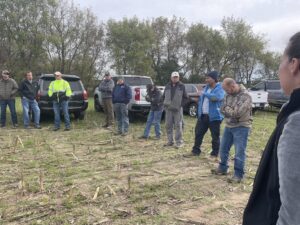
Western Wisconsin Conservation Council (WWCC) member, Greg Friendshuh, hosted a manure management field day in early October. Oxbo equipment demonstrated new technologies in manure application, Jerry Clark, UW Extension Regional Crop and Soils Educator and Jeff Jackson, DNR Wastewater Specialist presented methods to contain an unplanned manure release.
The demonstration field had a slight slope and is part of Greg’s feed production plan. Due to the short distance from the field to the farm, the goal for this field is to be no till and used for corn silage for 10 years. This year was the sixth year in the plan and the results have been satisfactory with using rye as a cover crop. Typically, this field is planted green and used for manure disposal each year.
Jerry Clark presented the importance of creating a whole farm emergency plan for an unplanned manure release. A number of different situations should be covered while creating this plan such as the best procedure and identified people that need to be contacted to ensure a plan is in motion.
The definition of a spill is “Any amount that threatens surface or ground water,” says Jerry Clark. Jeff Jackson added, “best practice is to always call it in.”
If a spill takes place methods that can be used might include cultivating the ground, building a dam or berm, or spreading absorbent, dry waste feed or bedding on it to protect any water bodies. The demonstrated manure spill covered all three of these methods.
Oxbo demonstrated their AT4103 liquid manure applicator. This three- wheel slurry applicator minimizes compaction and provides the farmer with choices in fertilizer and manure applications. Different field management software can be used to keep application and driving patterns consistent as well.
